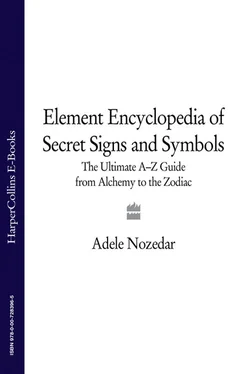Traditionally used as a wedding ring, the Claddagh is so-called because it was originally made in a Galway fishing village of the same name in seventeenth-century Ireland. However, the elements of the design are much older, stretching back into pre-Christian Celtic history. The Romans had a popular ring design, the Fede, which featured clasped hands. “Fede” means “fidelity.”
Of all the animal kingdom, man is unique in that he wears clothes. In the Bible, Adam and Eve don fig leaves to cover the newly discovered sexual parts that are a reminder of the lower animal nature. Once we had managed to protect our modesty and keep ourselves warm, our attention turned to the use of clothes as an outward sign of status or of certain religious observances. As secret symbols, clothes have an elaborate history, especially when they are connected to religious beliefs; sacred texts from all religions are full of instructions as to the nature of certain clothes and how they should be worn. This section doesn’t claim to be an extensive analysis of these ideas, but serves merely to point out the meanings of some of the most common items of apparel.
The cape has a simple design. At its most basic, it is a piece of cloth with a hole in the middle. Often worn by members of the clergy, when it is called a “chasuble,” the cape shares the same symbolism as the arc or dome that it represents; the vault of the Heavens. This suggests the idea of ascendance. The wearer of the cape becomes a living representation of the Axis Mundi.
As well as being a symbol of religious asceticism, the cloak is the garment of kings. In addition, the word “cloak” has become synonymous with the notion of hiding something; the invisibility cloak is a very ancient idea. The God, Lugh, had such a cloak that enabled him to pass unnoticed through the entire Irish army in order to rescue his son. Effectively, though, the cloak makes the wearer invisible without any need for magical intervention. A cloak, especially a hooded one, is a mask for the body, covering the wearer from head to foot. A cloak can help someone change his or her identity while at the same time confirming it. In the Bible, St. Martin gives half his cloak to the beggar. This is not only a material gesture but also a symbol of his charitable nature.
The Khirka, a specific type of cloak, originally meant a scrap of torn material. However, its unworldly nature made it an appropriate garment for the Sufi mystic.
It was originally blue, signifying a vow of poverty, in the same way that brown and gray have the same meaning to Christian believers. The Sufi receives the Khirka after three years of training, a sign that he is worthy of initiation. To wear the Khirka, the Sufi must understand the three levels of the mystic life. These are the Truth, the Law, and the Path.
When you put your foot upon the ground, this gesture is synonymous with taking possession of the Earth beneath it.
Because the holy ground at churches and temples is not, effectively, a territory that belongs to man, the jumble of shoes, sandals, and boots outside the doors of holy places all over the world may certainly be a sign of respect. However, the owners may not be aware that they are, literally, following in the footsteps of a more ancient idea, that they have no claim to this sacred territory. The footwear is significant because it is removed.
The Children of Israel sealed agreements between two parties by swapping one sandal each. In addition, in Northern China the word for “slipper” and “mutual agreement” is the same. This is why slippers are given as wedding presents.
Shoes also symbolize travel, a meaning that precedes the time of motorized transport. In certain Northern European territories, children leave their shoes out for Father Christmas to fill with gifts; not only is Santa himself making an arduous journey, but his gifts help in the “journey” of the coming year.
Shoes are also a status symbol. Slaves generally went barefoot; hence, the wearing of shoes was the sign of the free man.
The slipper that Cinderella lost, that later proved her identity to the Prince, is an example of the shoe as a sexual symbol. In common interpretations of this tale these “slippers” sound uncomfortable, since they are apparently made of glass. However, it was an old European tradition that a potential suitor would show his sincerity by making his intended bride a pair of fur boots. It is likely that the word for fur, vair , was confused with the word for glass, verre. The sexual symbolism continues with these kinky boots; the old word for fur shares its roots with a word meaning “sheath.”
Often the very first piece of clothing to be worn, especially in Asian countries, the girdle or belt is circular, and so it represents the union of spirit and matter, and of eternity. It also symbolizes the binding aspect; the girdle is a synonym for the soul that is bound to the body. Although the girdle is tied around the waist of a baby at birth in some countries, it appears in various other forms. The belts of the martial arts exponent range through the color spectrum from white to black to signify levels of expertise.
The girdle also protects; it acts as a symbolic “wall” through which evil entities cannot penetrate. It’s a sort of spiritual utility belt. The girdle, too, represents the idea of chastity. The belt worn around robes of monks and others who are called to a spiritual life carries the greater significance of the girdle. Notably, in the Middle Ages prostitutes were allowed to wear neither belt nor veil.
To talk of “girding the loins” means to prepare oneself, whether for a journey or something else. The ankh is called the Girdle of Isis or the Buckle of Isis, and carries the same notions of the circle and the knot as binding forces.
A sash is also a kind of girdle, used in Freemasonry, for example, as a symbol of office. The knot itself is often used as a reminder, and the knot in the girdle or belt is a reminder of the promise made when the girdle was donned.
Another form of a girdle is the Sacred Thread, or Poonal (in Tamil) that is worn by male Hindus, particularly those from the Brahmin caste. The Sacred Thread ceremony can happen any time after the boy’s seventh birthday. The thread is handwoven from three sets of three strands, although extra strands are added to represent marriage and children. It measures about 96 times the breadth of a man’s four fingers; this is roughly the same as his height. Resting on the left shoulder, the thread is wrapped around the body, ending under the right arm. It is knotted only once. Once the Sacred Thread ceremony has been carried out, the thread is never taken off although it is replaced once a year. The single knot represents the concept of Brahman, the unity of all things. The numbers of strands in the thread signify various tenets of the Hindu faith.
Freemasons sometimes wear white gloves, not only as a symbol of work to be done, but also to show purity of thought. White gloves are worn for the same reasons in the Catholic Church. They are given to bishops and kings after their investiture, and here they are a reminder of newborn purity. Gloves—especially the highly ornamented kind—are a relatively luxurious item of clothing, emblems of the nobility who used gauntlets as part of the equipment associated with falconry. Gloves on heraldic shields usually indicate some connection with hunting birds.
To “throw down the gauntlet” is still used as a synonym for a challenge, dating back to the days of chivalry, where it was a politer version of a slap but hardly any less shocking.
Читать дальше












